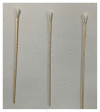Bedside Examination Technique for Taste
- PMID: 37655140
- PMCID: PMC10467592
- DOI: 10.21315/mjms2023.30.4.17
Bedside Examination Technique for Taste
Abstract
Taste disorders are uncommon and frequently unrecognised during neurological and even oral examinations. Nevertheless, understanding taste pathway, its disorders, as well as assessment of taste are crucial as it can reveal various oral, systemic and neurological pathologies that manifest as an alteration of taste. Multiple taste examination techniques have been described in the literature; however, certain techniques are complicated and may not be feasible. This paper describes the adoption of a relatively simple technique for taste assessment that can be performed at the bedside. The bedside detection of taste disorders will allow examiners to assign the patient for more detailed and invasive taste assessments.
Keywords: bedside examination technique for taste; taste disorders; taste pathway.
© Penerbit Universiti Sains Malaysia, 2023.
Conflict of interest statement
Conflict of Interest None.
Figures



References
-
- Barry MA, Frank ME. Taste. In: Ramachandran VS, editor. Encyclopedia of the human brain. Academy Press; 2002. pp. 557–567. - DOI
-
- Barrett KE, Barman SM, Boitano S, Brooks HL. Smell & taste. In: Barrett KE, Barman SM, Boitano S, Brooks HL, editors. Ganong’s review of medical physiology. 25e. McGraw-Hill Education; 2018. [Retrieved 2022 July 17]. Available at: https://accessmedicine.mhmedical.com/content.aspx?bookid=1587§ionid=....
LinkOut - more resources
Full Text Sources
